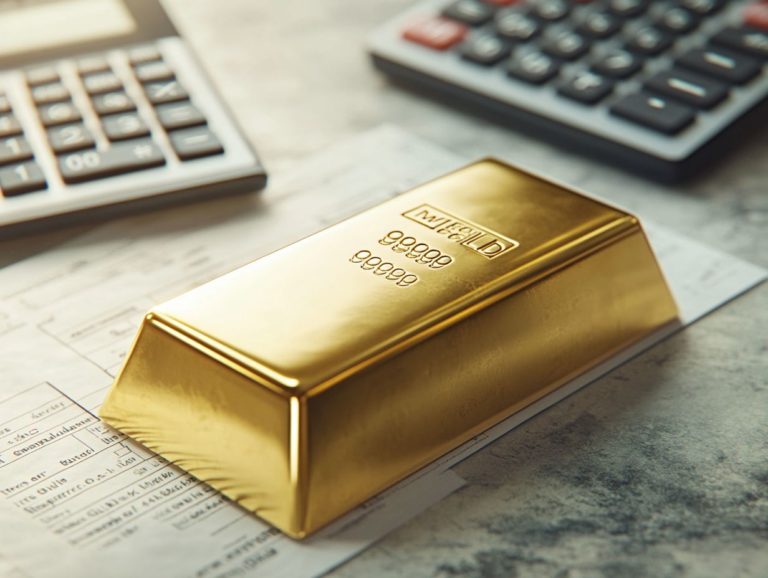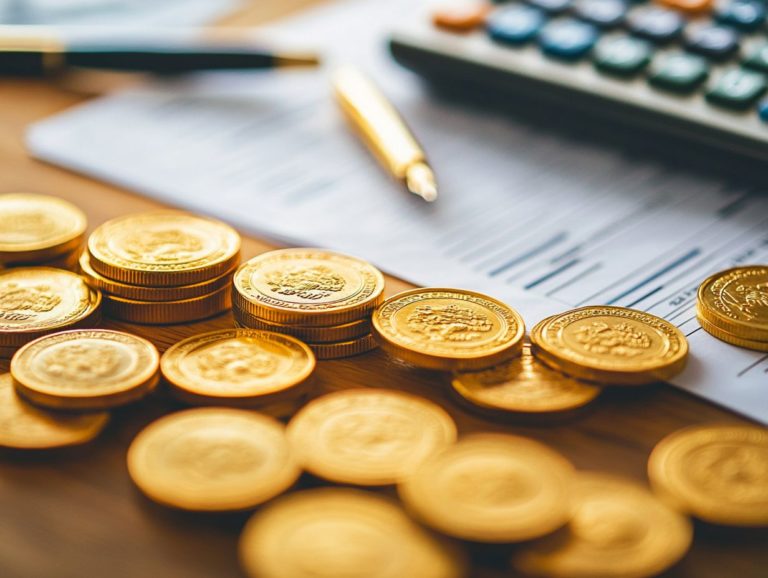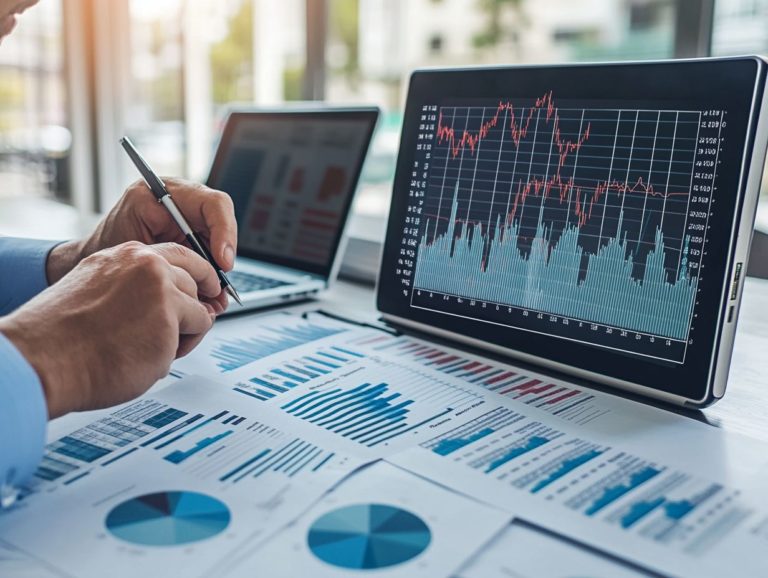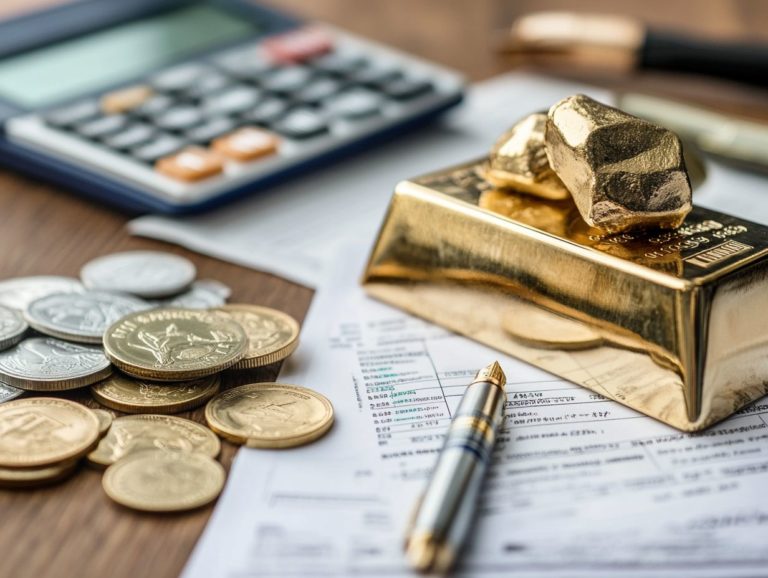Retirement Accounts: Tax Advantages for Precious Metals
Retirement accounts present a strategic avenue for securing your financial future. Integrating precious metals can significantly elevate both your portfolio and tax advantages.
This article delves into the distinct benefits of incorporating precious metals, such as gold and silver, into your retirement accounts. You ll gain insight into eligible metals, the regulations governing them, and a comprehensive guide on how to add these assets to your portfolio seamlessly.
This article also discusses potential risks and strategies aimed at maximizing your tax benefits.
Discover how precious metals can be a game-changer for your retirement!
Contents
- Key Takeaways:
- Tax Advantages of Precious Metals in Retirement Accounts
- Types of Precious Metals Allowed in Retirement Accounts
- How to Add Precious Metals to Your Retirement Account
- Potential Risks and Considerations
- Maximizing Tax Benefits with Precious Metals in Retirement Accounts
- Frequently Asked Questions
- 1. What are the tax advantages of investing in precious metals through retirement accounts?
- 2. Can I use a traditional IRA to invest in precious metals?
- 3. Are there any limitations on the types of precious metals I can invest in through retirement accounts?
- 4. How are taxes handled when I sell precious metals in my retirement account?
- 5. Can I roll over funds from an existing retirement account into a precious metals IRA?
- 6. Are there any risks associated with investing in precious metals through retirement accounts?
Key Takeaways:
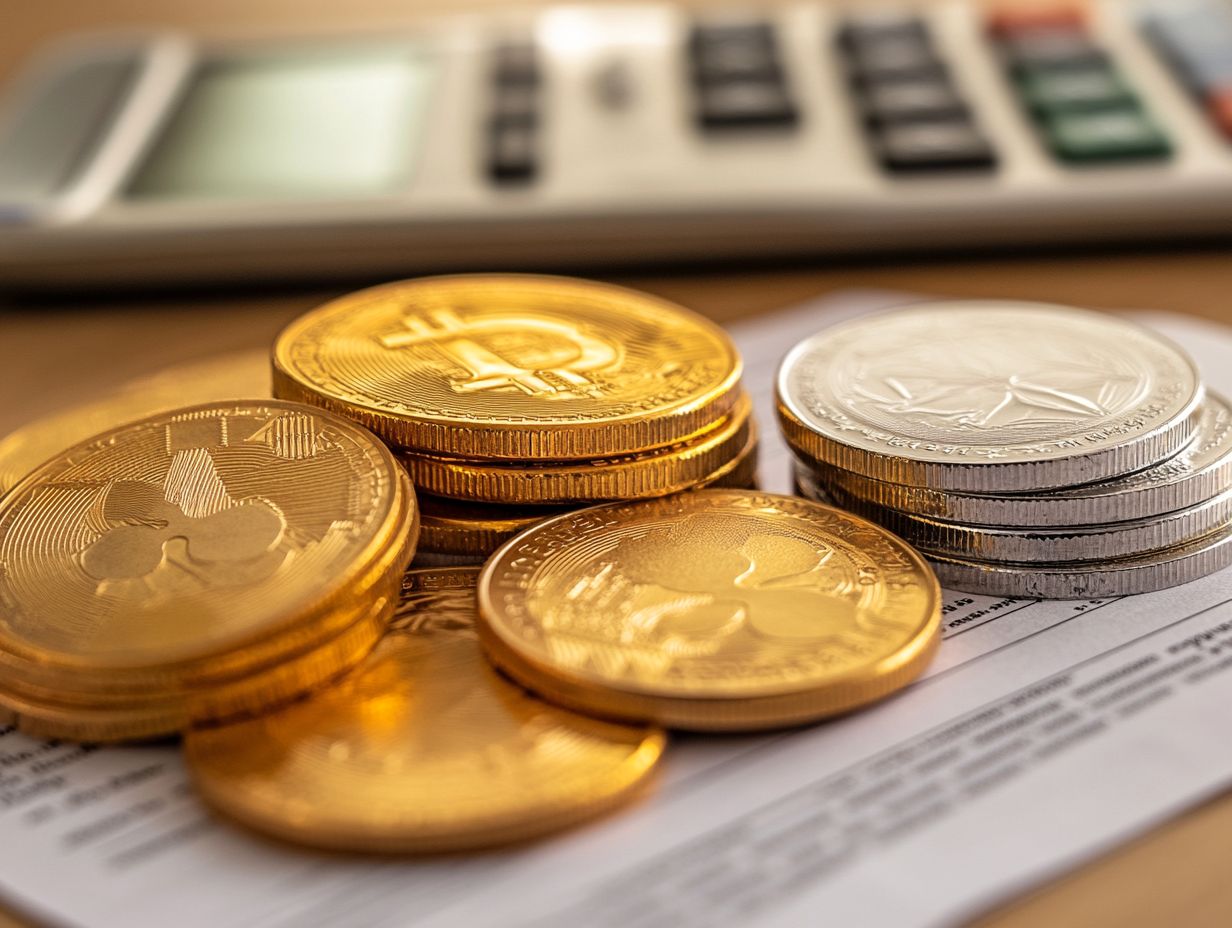
- Adding precious metals to retirement accounts can provide tax benefits, such as tax-deferred growth and potential tax savings at retirement.
- Eligible metals for retirement accounts include gold, silver, platinum, and palladium; rules and regulations may vary by account type.
- To maximize tax advantages, consider diversifying your retirement portfolio with precious metals and reassessing risks and potential benefits regularly.
What are Retirement Accounts?
Retirement accounts are essential financial tools. They help you save and invest for a secure future, ensuring you enjoy your golden years without financial worries.
Options like Individual Retirement Accounts (IRAs) and self-directed IRAs, which allow you more control over your investments, provide a wealth of investment choices. You can build diversified portfolios that include stocks, bonds, and even alternative assets like gold and precious metals.
It s vital to grasp the intricate details of these retirement plans, including IRS regulations, contribution limits, and withdrawal options. This knowledge helps you make the most of your retirement savings and create tax-efficient shelters for your investments.
Beyond traditional and Roth IRAs, you also have the opportunity to utilize employer-sponsored retirement plans like 401(k)s. These often come with matching contributions to supercharge your savings potential.
Each type of account operates under distinct rules. For instance, traditional IRAs allow for tax-deductible contributions, while Roth IRAs offer tax-free withdrawals when you retire.
Diversifying your investments helps you navigate market fluctuations and potentially elevate your overall wealth. Staying compliant with IRS regulations is crucial; it helps you avoid penalties and optimize growth, underscoring the importance of knowledge-based decision making in your retirement planning.
Tax Advantages of Precious Metals in Retirement Accounts
Incorporating precious metals into your retirement accounts provides unique tax advantages that can significantly enhance your investment portfolio’s performance, especially during periods of economic uncertainty.
By leveraging IRS-backed options like gold IRAs, you can enjoy a tax-efficient shelter for your retirement funds, potentially safeguarding your wealth against inflation and market volatility.
It s crucial to grasp these tax implications and regulations if you re considering diversifying your investment strategy with physical assets.
Overview of Tax Benefits
The tax benefits of utilizing retirement accounts for precious metals investments can profoundly shape your long-term financial outcomes. These benefits provide pathways for both wealth protection and growth.
By choosing a gold IRA, you gain access to unique tax structures that allow your assets to grow tax-deferred, enhancing your overall investment performance. To fully benefit from this investment, it’s important to understand the tax effects of precious metals investments. This strategy serves as a hedge against inflation, making it an appealing choice in today’s unpredictable economic environment.
What this means for you is that profits from the sale of gold or other approved metals won’t face immediate taxation. Instead, you can reinvest your gains without the weight of annual tax liabilities, leading to compounded growth over time.
You may also find advantages in tax-free distributions during retirement, provided certain conditions are met. These features bolster your wealth accumulation and align seamlessly with broader financial strategies that prioritize security and sustainable growth.
Ultimately, these attributes make precious metals an attractive option for diversifying your retirement portfolio while maximizing tax efficiency.
Start exploring your options in precious metals today to secure your financial future!
Types of Precious Metals Allowed in Retirement Accounts
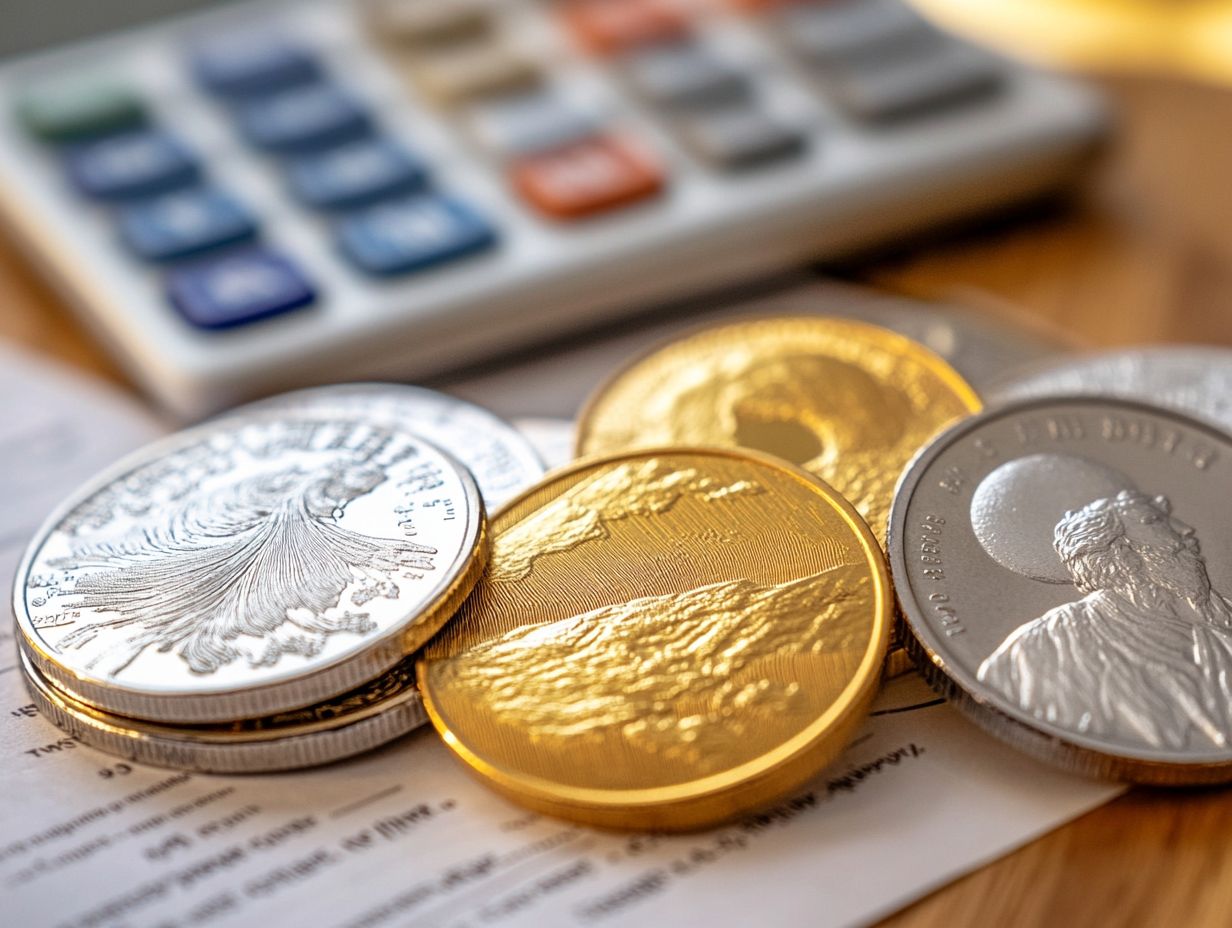
Understanding the various types of precious metals that can be incorporated into retirement accounts is essential for you as an investor aiming to diversify your portfolio with tangible assets.
According to IRS regulations, eligible options include gold bars, American Eagle coins, and Canadian Maple Leaf coins. These choices offer wealth protection and inflation hedging.
Each type of metal carries its own investment risks and performance characteristics. These factors can influence your decisions when crafting long-term retirement strategies.
Eligible Metals and Regulations
Eligible metals for inclusion in your retirement accounts are precisely defined by IRS regulations. These guidelines help you make informed choices that align with legal standards. For gold IRAs, ensure that the metals meet specific fineness criteria, which can encompass gold, silver, platinum, and palladium. This consideration is crucial, as it directly impacts the investment risk associated with each metal’s market performance.
To qualify, gold must have a purity level of at least 99.5%, while silver needs to be 99.9% pure. These stringent standards serve as protective measures for you as an investor, ensuring that your assets maintain a quality that can endure market fluctuations.
The implications of these regulations extend beyond compliance; they significantly influence the overall performance and future value of the metals in your retirement accounts. This helps you construct a robust portfolio that adheres to IRS guidelines while effectively navigating potential market risks.
How to Add Precious Metals to Your Retirement Account
Adding precious metals to your retirement account is a meticulous journey that requires thoughtful planning and adherence to IRS regulations, especially when working with a self-directed IRA. A self-directed IRA lets you manage your own investments, including precious metals.
You ll need to choose a reputable precious metals dealer and coordinate the purchase. Ensure the metals are stored in an approved depository. This not only helps you avoid custodial and transaction fees but also strengthens your overall strategy.
A comprehensive grasp of this process is key to mitigating investment risks and enriching your portfolio diversification.
Step-by-Step Process
The process for adding precious metals to your retirement account starts with selecting the right type of account, such as a self-directed IRA, which allows for these valuable investments.
Next, identify a reputable precious metals dealer. Look for those offering American Eagle or Canadian Maple Leaf coins, and arrange for purchasing and securely storing your assets in an IRS-approved depository.
To facilitate a seamless transition, conduct thorough research on potential dealers. Compare their prices, reputations, and customer reviews. Once you ve settled on a dealer, ensure they provide secure payment options. Document all transactions meticulously, keeping records of invoices, receipts, and any correspondence.
Then, shift your focus to storage. Choose a depository that meets IRS requirements and offers robust security measures, along with insurance for added peace of mind. Regularly review your investments to ensure they align with your retirement goals and adapt to changing market conditions.
Potential Risks and Considerations

Investing in precious metals can be exhilarating, but it comes with risks you must understand. During periods of market volatility and economic downturns, price fluctuations in metals and shifts in IRS regulations can significantly influence the overall performance of your investment.
Understand these risks now to protect your future savings. Grasping these factors is essential for making informed decisions about your retirement strategy.
Assessing Risks and Making Informed Decisions
Assessing the risks associated with precious metals in your retirement accounts is crucial for making informed decisions that align with your financial goals. Take the time to analyze market performance, historical volatility, and various economic scenarios. These insights will guide your approach and help you mitigate investment risks.
By employing strategies that consider these factors, you can optimize your retirement accounts for enhanced wealth protection.
Understanding how global economic indicators influence the precious metals market offers valuable insights. For instance, fluctuations in currency strength, inflation rates, and geopolitical events significantly impact the value of these investments.
Conducting a thorough analysis of historical price trends can reveal patterns that aid in predicting future movements. By incorporating these elements into your risk management strategies, you foster a comprehensive approach to investment performance. This allows you to prepare for the inevitable market volatility that comes with precious metal investments.
Maximizing Tax Benefits with Precious Metals in Retirement Accounts
Maximizing tax benefits with precious metals in your retirement accounts requires a strategic approach that navigates various investment options while ensuring compliance with IRS regulations. Collaborating with a knowledgeable financial advisor and understanding the details of tax-efficient shelters can significantly enhance your retirement funds.
This proactive strategy bolsters overall investment performance and fortifies your wealth against inflation and market volatility. It paves the way for a more secure financial future.
Strategies and Tips for Maximizing Tax Advantages
Implementing effective strategies and tips to maximize tax advantages with precious metals in your retirement accounts can lead to significant financial benefits and refined investment choices. Understanding the intricacies of different retirement funds and the eligibility criteria for precious metals empowers you to make decisions that enhance tax efficiency and reduce potential liabilities.
Diversifying your portfolio with gold, silver, and other precious metals helps you hedge against inflation and allows for tax-deferred growth. Familiarizing yourself with tax regulations for precious metals in retirement accounts is essential to ensure compliance and avoid costly penalties.
Financial planning plays a crucial role in this process. Tailoring your investment choices to your individual circumstances enables you to effectively utilize tax shelters like IRAs or 401(k)s. Consulting with tax professionals can illuminate pathways for maximizing deductions and credits, ultimately positioning you for a more robust financial future.
Frequently Asked Questions
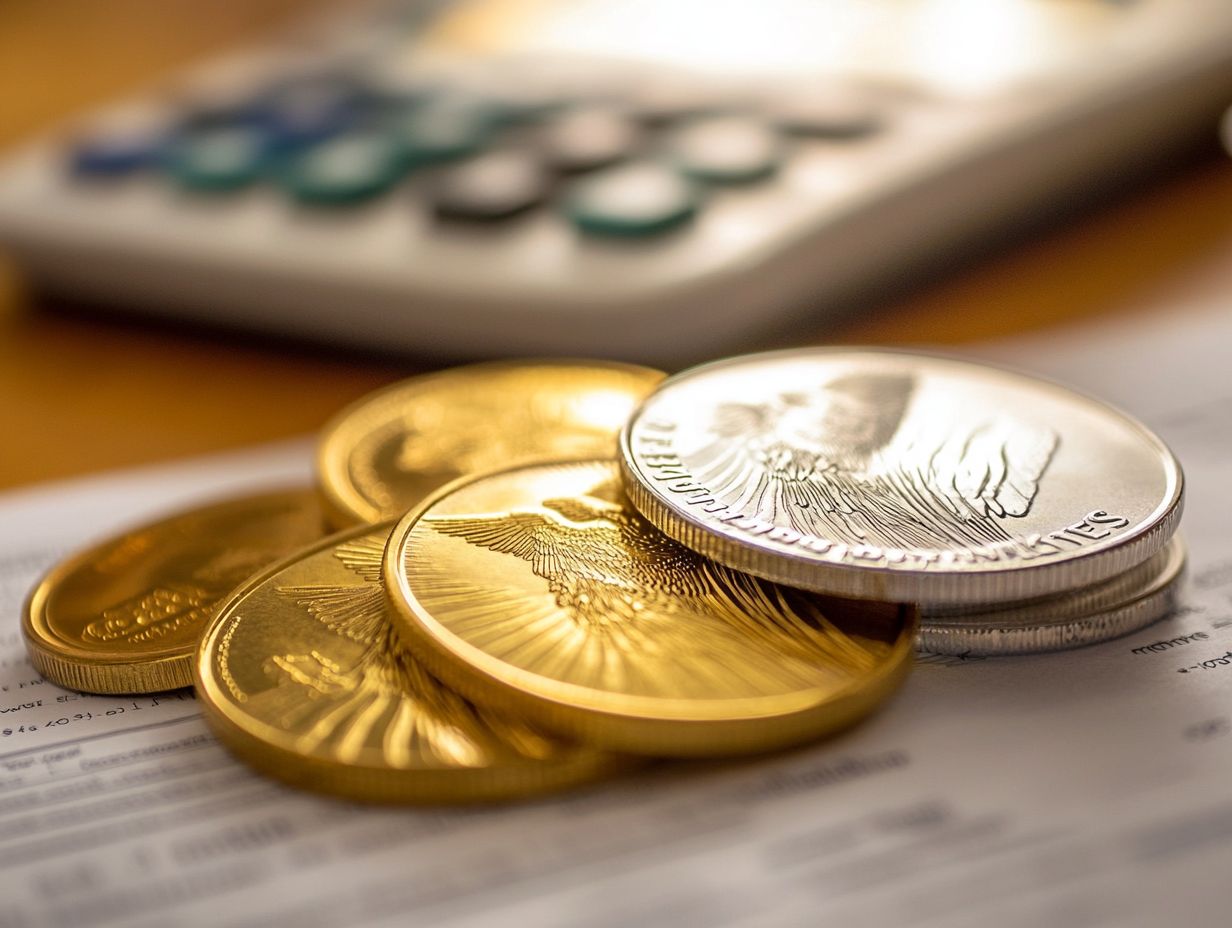
1. What are the tax advantages of investing in precious metals through retirement accounts?
Investing in precious metals, such as gold or silver, through retirement accounts offers several tax advantages, including:
- Tax-deferred growth
- Tax-free transfers
- Potential tax deductions on contributions
2. Can I use a traditional IRA to invest in precious metals?
Yes, you can use a traditional IRA to invest in precious metals. However, you’ll need to set up a self-directed IRA with a custodian that allows for alternative investments. This setup enables you to purchase and hold physical precious metals in your retirement account.
3. Are there any limitations on the types of precious metals I can invest in through retirement accounts?
Yes, there are limitations on the types of precious metals that can be held in retirement accounts. Only certain types of gold, silver, platinum, and palladium coins and bars that meet specific purity requirements are allowed.
4. How are taxes handled when I sell precious metals in my retirement account?
When you sell precious metals in your retirement account, the tax implications depend on the type of account you have:
- If you have a traditional IRA, the profits will be taxed as regular income.
- If you have a Roth IRA, the profits will be tax-free as long as certain requirements are met.
5. Can I roll over funds from an existing retirement account into a precious metals IRA?
Yes, you can roll over funds from an existing retirement account, like a 401(k) or traditional IRA, into a precious metals IRA.
This process is called a direct rollover, and it allows you to transfer without facing taxes or penalties.
6. Are there any risks associated with investing in precious metals through retirement accounts?
Yes, investing in precious metals carries some risks.
These include market value fluctuations, potential fees from your account manager, and restrictions on accessing your funds until retirement age.











